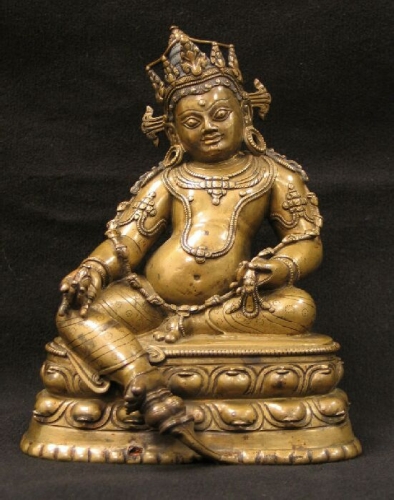Buddhist practice and Buddhist art have been inseparable in the Himalayas ever since Buddhism arrived to the region in the eighth century. But for the casual observer it can be difficult to make sense of the complex iconography. Not to worry—Himalayan art scholar Jeff Watt is here to help. In this “Himalayan Buddhist Art 101” series, Jeff is making sense of this rich artistic tradition by presenting weekly images from the Himalayan Art Resources archives and explaining their roles in the Buddhist tradition.
This week Jeff explores a subcategory of meditational deities called wealth deities. Read on to learn more about Jambhala, a popular Himalayan wealth deity.
Wealth Deities
Although wealth deities are extremely popular in tantric Buddhism, their purpose and function is often misunderstood. Of course, there is the obvious purpose—the deities are for acquiring wealth and amassing a fortune—but how this is understood comes from a religious perspective, not a material one.

Wealth deities have the function of assisting religious practitioners in acquiring the necessary worldly goods and support materials in order to continue along the path of religious practice. Wealth deities are also employed for accomplishing other religious goals such as feeding the poor, giving medicine to the sick, funding pilgrimages, and the building of stupas and religious centers. Wealth practices are intended for religious and spiritual goals—not for personal gain.
In general, wealth deities are a subcategory of meditational deities. The majority of wealth deities are regarded as enlightened figures or emanations of enlightened deities such a Vajradhara or the Five Symbolic Buddhas. They are best understood as minor meditational deities that belong to larger and more important tantric systems of practice such as Chakrasamvara, Hevajra and Kalachakra.

The wealth deity that is most commonly depicted in Himalayan art is Jambhala, a male figure yellow in color with one face and two arms. His special physical characteristics are a broad face with a mustache, slight beard, and round open eyes that are almost glaring. His torso is large and slightly corpulent, with short limbs. This appearance is based on the Indian model of a Yaksha spirit and is also used in Himalayan art to represent Indian and Tibetan kings.
The most general and classic form of Jambhala follows the description above. There are, however, many other forms that differ in color and number of faces and arms. Some of them are specific to certain systems of tantric practice, such as White Jambahala with Avalokiteshvara and Green Jambhala with the Kalachakra tantric system.
The female counterpart to Jambhala is Yellow Vasudhara, who also has one face and two hands. She is similar in appearance to Tara, but a more correct interpretation of textual iconography describes female wealth deity figures as slightly corpulent, healthy, and full-bodied. Jambhala and Vasudhara are considered a couple and in some iconographic depictions are portrayed together, often with Vasudhara as the dominant figure.
Thank you for subscribing to Tricycle! As a nonprofit, we depend on readers like you to keep Buddhist teachings and practices widely available.